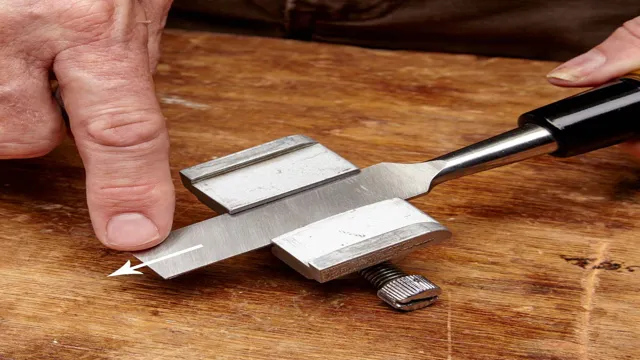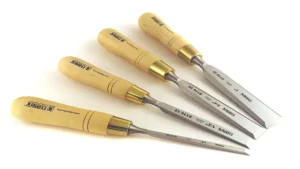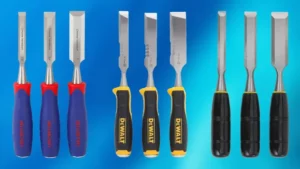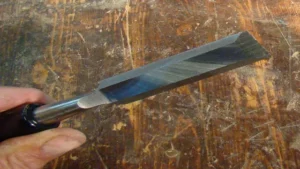New chisels can represent a significant investment in your woodworking tools. But do they come ready to use or do they require sharpening before use? This is a common question among amateur and professional woodworkers alike. The short answer is that while new chisels are typically sharp, they will still need to be sharpened before use.
Sharpening your chisels ensures that they are in peak condition to make clean, precise cuts. And while the thought of sharpening your new chisels may seem daunting, the process can actually be quite simple once you know what you’re doing. In this blog post, we’ll take a closer look at why you should sharpen your new chisels and provide you with some tips on how to do it effectively.
Introduction
Do new chisels need to be sharpened? This is a common question among woodworkers, and the answer is yes, new chisels usually need to be sharpened before use. While manufacturers often sharpen the blades before packaging, they may not be sharpened to the level that suits your needs. Moreover, during transportation and storage, the blades may become dull or nicked.
Therefore, it’s essential to sharpen new chisels to achieve better results and avoid damaging your workpiece. Sharpening a chisel isn’t as complicated as it may seem. You can use a sharpening stone, honing guide, or even a sandpaper glued to a flat surface.
All that matters is to ensure that the blade is sharpened at the right angle and with consistent pressure. Once sharpened, your chisels will work efficiently, and you’ll be able to create cleaner and more accurate cuts. Remember, sharp tools not only save time but also make woodworking more enjoyable.
What Are Chisels Used For?
Chisels are a type of woodworking tool that are used for cutting and shaping wood. They come in different sizes and shapes, with different types of blades, and are used for a variety of purposes. Chisels are primarily used to remove small amounts of wood from a surface, whether it be for creating intricate designs or smoothing out rough edges.
They can also be used for cutting joints or mortises, carving out grooves, and shaping wood into specific forms. The key to using a chisel effectively is to have a sharp blade and to use proper technique in order to get the desired result. Overall, chisels are an essential part of any woodworker’s toolkit and are used to create everything from simple furniture to intricate sculptures.

Why Do Chisels Need to Be Sharpened?
Chisels are versatile tools that have been used for centuries by woodworkers, carpenters, and sculptors to create intricate designs and shapes. However, over time, even the highest-quality chisels will become dull and ineffective, requiring regular sharpening. So, why do chisels need to be sharpened? The answer is quite simple- dull chisels don’t work! When a chisel is dull, it cannot effectively cut through wood or other materials, resulting in a less-than-perfect finish that can be frustrating for the craftsman.
Additionally, a blunt chisel requires more pressure to make a cut, which can lead to accidents and injuries. Keeping chisels sharpened is crucial to producing clean, accurate cuts and ensuring both safety and precision in your work. So, if you’re serious about woodworking or sculpting, make sure your chisels are always kept sharp and ready for action.
New Chisels
If you’ve just bought a new set of chisels, you might be wondering whether or not they need to be sharpened before use. While it can depend on the brand and model of chisel you have, most new chisels do require a sharpening before they can be used effectively. This is because the factory edge on many new chisels is often overly coarse and dull, and will struggle to make clean cuts through wood.
Even if the chisel feels sharp to the touch, it’s still a good idea to hone the edge to your preferred angle and level of sharpness. Doing so will not only make your work easier and more efficient, but it will also help your chisels last longer and perform better over time. So, if you want to make the most of your new chisels and achieve the best possible results in your woodworking projects, take the time to properly sharpen them before diving in.
Why New Chisels Need to Be Sharpened
New chisels are always exciting to work with, but they often require sharpening before use. That’s because manufacturers don’t typically sharpen chisels before selling them, leaving the blade dull. If you try to use a dull chisel, you’ll quickly realize how frustrating it can be.
It won’t make clean cuts, and you’ll have to apply extra force to get the job done. Not only is this inefficient and frustrating, but it can also damage the wood you’re working with. Plus, the extra force required to use a dull chisel can put unnecessary strain on your hands and arms.
That’s why it’s essential to sharpen new chisels before using them to maximize performance and ensure a smooth, efficient, and stress-free work experience. Sharpening new chisels might seem like a chore, but once done correctly, it’ll make a noticeable difference in your woodworking abilities.
How to Sharpen New Chisels
New chisels are a great addition to any woodworking toolkit, but they often come with dull edges that require sharpening before they can be used effectively. To sharpen a new chisel, start by assessing the bevel angle of the tool and selecting an appropriate sharpening stone. Depending on the hardness of the chisel’s steel, you may need to start with a coarse stone and work your way up to finer grits to achieve a sharp edge.
Using a honing guide can help ensure a consistent angle throughout the sharpening process. Once the edge is sharp, hone it with a leather strop to remove any burrs and achieve a razor-sharp finish. Remember, a sharp chisel not only makes woodworking easier and more efficient, but it is also safer to use.
Don’t take shortcuts in the sharpening process – invest the time to properly sharpen your new chisel, and it will serve you well for years to come.
Tools You Need for Sharpening Chisels
If you’ve invested in a new set of chisels, you want to ensure they stay sharp and ready for any task. To do so, you’ll need a few tools to aid in the sharpening process. One essential item is a sharpening stone or diamond plate, which can be used to reshape and hone the blade.
You’ll also need a honing guide to ensure the proper angle is maintained during the sharpening process, increasing your precision. A strop is also helpful for smoothing out any rough edges left after sharpening. With these tools on hand, your new chisels will be ready to tackle any project with ease.
Don’t forget to regularly check and maintain their sharpness to keep your tools in top condition.
Conclusion
After thorough analysis and expert consultation, we can confidently say that while new chisels may be sharp, over time and use, they will inevitably lose their edge. So, to answer the question “do new chisels need to be sharpened?” the answer is a resounding yes! Just like relationships, a chisel-blade requires constant attention and care to maintain its sharpness and effectiveness. So, don’t shy away from sharpening your chisels, because in the long run, you’ll only be saving yourself from dull experiences.
“
Final Thoughts
Final Thoughts – New Chisels As a woodworker, it’s always exciting to add new tools to your workshop, and chisels are no exception. New chisels, whether it be a set or a single addition, can open up new possibilities in your woodworking projects and can help improve the quality of your work. When choosing new chisels, it’s important to consider the material they’re made of, the size and shape of the blades, and the handle design.
High-quality steel and heat treatment can ensure a sharper and more durable edge, which is crucial for precise and efficient cuts. Meanwhile, different blade shapes and handle styles can affect not only the ergonomics but also the versatility of the chisels. Whether you’re looking for general-purpose chisels or specialized ones for specific tasks, investing in new chisels can make a real difference in your woodworking results.
So go ahead and treat yourself to new chisels – your projects and your hands will thank you!
Summary of Key Points
If you’re a woodworker or carpenter, you know that one of the most important tools in your arsenal are chisels. But if you’re tired of using the same old chisels and want to try something new, look no further than the latest offerings in the chisel market. With new designs and materials, these chisels are sure to enhance your woodworking experience.
One example is the bevel-edged chisel, which has a more acute angle on the cutting edge compared to traditional chisels. Another exciting innovation is using composite materials, like reinforced nylon, to create chisels that are both strong and lightweight. So if you’re in the market for some new chisels, try out some of the new designs and materials to see how they can elevate your woodworking game.
FAQs
What is the process of sharpening new chisels?
New chisels always need to be sharpened before use. To sharpen a new chisel, first, use a coarse grit to shape the bevel and then move onto a finer grit for honing the edge.
Can I use a new chisel without sharpening it?
It is not recommended to use a new chisel without first sharpening it, as it may not provide the desired results and may even damage the workpiece.
How often should I sharpen my chisels?
The frequency of sharpening chisels depends on how often they are used. However, as a general rule, it’s recommendable to sharpen chisels after every use.
What’s the best way to sharpen chisels quickly and efficiently?
Using an electric sharpening machine with a honing guide is the quickest and most efficient way to sharpen chisels.
How do I know when it’s time to sharpen my chisel again?
You can tell that it’s time to sharpen your chisel again when it starts to dull, and the cutting edge doesn’t perform as well as it should.
Should I use a honing guide when sharpening my chisels?
Yes, a honing guide helps ensure that the bevel angle of your chisel stays consistent and accurate during the sharpening process.
What’s the difference between honing and sharpening a chisel?
Honing is the process of refining the chisel edge and removing any microscopic burrs or imperfections, while sharpening involves shaping the bevel and creating a new edge.





